Dry Eye Syndrome

Comprehensive Care for Dry Eye Syndrome
At Nav Drishti Eye Centre, we understand the discomfort and impact of Dry Eye Syndrome, a condition where your eyes do not produce enough tears or the right quality of tears to stay adequately lubricated.
- This can lead to irritation, redness, and a gritty feeling in the eyes.
- Our expert team provides advanced diagnostic and treatment options to alleviate symptoms, improve tear production, and enhance your overall eye comfort.
- We are committed to helping you maintain healthy, comfortable eyes and clear vision.
What is Dry Eye Syndrome?
- Definition: Dry Eye Syndrome occurs when the eyes do not produce enough tears or the right quality of tears, leading to discomfort, inflammation, and potential damage to the eye’s surface.
- Types:
- Aqueous-Deficient Dry Eye: Insufficient tear production due to issues with tear glands.
- Evaporative Dry Eye: Excessive evaporation of tears due to dysfunction of the meibomian glands (responsible for the oily layer of tears).
Symptoms to Watch For
- Dryness and Gritty Sensation: Persistent feeling of dryness, as if there is something gritty in the eye.
- Redness and Irritation: Visible redness and a burning or stinging sensation.
- Blurred Vision: Temporary blurring, especially after prolonged periods of reading or computer use.
- Excessive Tearing: Inconsistent with dryness, this occurs as a compensatory response to irritation.
- Sensitivity to Light: Increased sensitivity or discomfort when exposed to bright lights or sunlight.
- Eye Fatigue: Feeling of tiredness or heaviness in the eyes, especially after visual tasks.
Risk Factors
- Age: Tear production tends to decrease with age, increasing risk.
- Gender: Women are more susceptible, particularly during menopause or pregnancy due to hormonal changes.
- Medications: Certain medications like antihistamines, antidepressants, and blood pressure medications can reduce tear production.
- Environmental Conditions: Exposure to dry, windy, or smoky environments can exacerbate symptoms.
- Health Conditions: Systemic diseases such as rheumatoid arthritis, Sjögren’s syndrome, and diabetes can contribute to dry eye.
- Extended Use of Digital Devices: Prolonged screen time can reduce blinking rates, leading to tear evaporation.
Our Diagnostic Approach
- Comprehensive Eye Examination: Includes detailed assessments of the eye surface, tear production, and overall ocular health.
- Tear Breakup Time (TBUT) Test: Measures the time it takes for tears to break up on the eye’s surface to assess tear stability.
- Schirmer’s Test: Assesses tear production by measuring the amount of tear fluid produced over a specific period.
- Meibomian Gland Assessment: Evaluates the function of glands responsible for secreting the lipid layer of tears.
- Ocular Surface Staining: Uses dyes to identify areas of damage or dryness on the cornea and conjunctiva.
Effective Treatments We Offer
- Artificial Tears: Customizable eye drops designed to mimic natural tears and provide lubrication.
- Medications: Prescription eye drops such as anti-inflammatory agents (e.g., cyclosporine A) to reduce inflammation and stimulate tear production.
- Punctal Plugs: Small, biocompatible devices inserted into the tear ducts to decrease tear drainage and enhance lubrication.
- Lipiflow® Treatment: A device that provides thermal pulsation to improve the function of meibomian glands and enhance the quality of tears.
- Scleral Lenses: Special contact lenses that create a barrier over the cornea to retain moisture and protect the eye’s surface.
- Intense Pulsed Light (IPL) Therapy: A treatment that uses light to reduce inflammation and improve meibomian gland function.
Prevention and Management Tips
- Regular Eye Exams: Essential for early detection and personalized management of Dry Eye Syndrome.
- Hydration: Maintain adequate fluid intake to support overall health and tear production.
- Environmental Adjustments: Use a humidifier in dry environments and avoid direct airflow from fans or air conditioning.
- Screen Time Management: Follow the 20-20-20 rule—take a 20-second break every 20 minutes by looking at something 20 feet away to reduce digital eye strain.
- Healthy Diet: Incorporate omega-3 fatty acids, found in fish and flaxseeds, to support tear production and overall eye health.
- Proper Use of Medications: Consult with your doctor about potential side effects of medications that may contribute to dry eye.
Book Your Appointment
If you’re experiencing symptoms of Dry Eye Syndrome or need expert advice on managing your condition, contact Nav Drishti Eye Centre today. Our dedicated team is here to provide you with comprehensive care and effective solutions to enhance your eye comfort and overall health.
